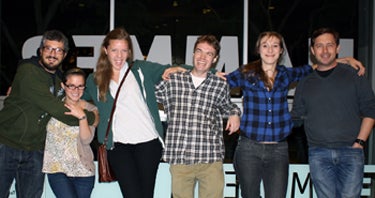The Archive’s “Out of the Past: Film Restoration Today” FREE film series—screening Monday nights this fall—continues through December 3, bringing a wide variety of rarely seen moving images as well as fascinating discussions with restorationists to the public.
"Hearst Metrotone News"
On October 22, the Archive’s own Blaine Bartell and Jeffrey Bickel joined us to present some of their latest work on the Hearst Metrotone News Collection. The Hearst newsreels date from 1914-1967 and amount to nearly 27 million feet and over 5,000 hours of footage. Bartell and Bickel have undertaken what they called the herculean “responsibility to preserve the entire collection” and shared some of their recent unearthed findings and challenges.
The collection contains not only complete newsreels, but also trims and outs that didn’t make the final cut. This included footage of a group of movie stars visiting France and we were treated to Rita Hayworth and Edward G. Robinson attempting to speak French. The camera, however, cutaway just as Ingrid Bergman was about to speak, much to the disappointment of the audience. Afterward, an audience member asked why this happened, and Bartell and Bickel explained that through the course of working with these materials, they have discovered that the cameramen were not always able to capture what would be of most interest today. They were sent only looking to get footage for a 1-minute story and could not benefit from the hindsight of history. Bartell also gave the example of Hearst’s coverage of Martin Luther King Jr.’s “I Have a Dream” speech, in which the cameraman was filming the audience when King utter those famous words.

Highlights of the footage in the various newsreels screened included: John F. Kennedy, Robert F. Kennedy, and Jimmy Hoffa at a Senate hearing; an incorrectly identified Anwar Sadat (noted at Emir Sendek) touring Disneyland with his family; a surprisingly neutral documentary on Fidel Castro made in in 1958; and a flying saucer enthusiast telling us--with a straight face--there will be massive alien landings in 1956.
Bartell spoke of how by preserving one newsreel for a specific purpose, for example a newsreel that covers the donation of Hearst Castle to the State of California, you also get “all these other great stories in it” and are often “pleasant[ly] surprised” with what you uncover. Bartell cited an example of finding footage of Leon Trotsky with Frida Kahlo, with no mention of Kahlo in any supporting documentation. From flying saucers to world leaders, the presentation demonstrated just what a rich and varied resource the Hearst Collection is (which can be accessed via the Archive Research and Study Center), as well as the inherent challenges in preserving it with limited resources and manpower.
The Flying Ace (1926)
Ken Weissman of the Library of Congress narrowly beat Hurricane Sandy to join us on October 29 to present the silent adventure film with an all black cast, The Flying Ace (1926). Weissman took us through the film’s unique history and its donation to the Library of Congress, without restrictions, in 1980 by the son of Norman Film Company Founder, Richard Norman. Norman was one of the very few producers of African-American cinema before the 1970s, making this film one of particular historical significance.
After donation to the Library of Congress, the film underwent an interesting preservation journey, and has been restored there 3 times. The Flying Ace was first restored in 1982 to lackluster results and following the Library’s purchase of new and better film printer, the film was again restored in 1986. The Flying Ace then laid dormant for many years until the San Francisco Silent Film Festival approached the Library about a new print in 2010 and Weissman was given a shot at the film using different and improved equipment.
Weissman showed the audience the original inspection reports from the 1982 and 1986 restorations and pointed out the many inaccuracies in the work. In the 1986 report, the inspector noted the film had an “irregular soundtrack,” which was impossible as it is a SILENT film. These reports served to illustrate one of Weissman’s major “pet peeves” and he emphasized for the students in attendance the importance of “accurately documenting work” so that “50 years from now someone can understand” the film’s condition.
The 2010 restoration allowed Weissman to put scenes back in order, an issue that was originally noted in the 1982 report. While this restoration was accomplished completely photochemically, Weissman did speak of the potential for digital restoration techniques on the film. He showed images of spot damage present on The Flying Ace and explained how these could be cleaned up using the digital sampling techniques now available, but also noted how one must be careful that these sampling programs do not remove subtle highlights in the images that could be construed as errors by the computer.
This brought up another important archival question concerning correcting visual deficiencies. Say, for example, there was a hair caught in a camera while originally filming that left a trace on film frames. While this defect was original to the film, it was not intentional, so the question of whether to fix it can be a complex one. For Weissman, however, the decision comes down to a simple idea: It “doesn’t matter which you choose, but document it…at least you told the story.”
"Amatuer Films from the Academy Film Archive"
Lynne Kirste brought a unique collection of Amateur Films from the Academy Film Archive on November 5. These home movies, if you will, are rarely screened in a public forum and Kirste took the opportunity to detail many of the challenges and joys of working with amateur film.
The Academy Film Archive’s home movie collection totals around 2,500 films and focuses on three main areas: films related to motion picture making (behind-the-scenes footage, home movies of members of the film industry, etc.); footage of the greater Los Angeles area; and home movies of people underrepresented in mainstream cinema.
 Unlike the process of restoring feature and commercial films, Kirste noted that with home movies you are usually working with the “one and only element.” There are not prints hiding in other archives throughout the world and the films are usually shot on reversal film stock, which was not intended to be copied. Cataloging is also a bit more challenging for home movies; there is often no set title and the descriptions can be in the form of extensive shot lists. Even when describing in detail the footage on each film, it is often impossible to anticipate what someone will find interesting. Kirste gave an example of a gentleman user who was fascinated by the incredible footage of airplane engines in a particular film.
Unlike the process of restoring feature and commercial films, Kirste noted that with home movies you are usually working with the “one and only element.” There are not prints hiding in other archives throughout the world and the films are usually shot on reversal film stock, which was not intended to be copied. Cataloging is also a bit more challenging for home movies; there is often no set title and the descriptions can be in the form of extensive shot lists. Even when describing in detail the footage on each film, it is often impossible to anticipate what someone will find interesting. Kirste gave an example of a gentleman user who was fascinated by the incredible footage of airplane engines in a particular film.
In addition to behind-the-scenes footage of Gone with the Wind (1939) and cinematographer James Wong Howe, Kirste shared her favorite discovery in the entire collection, footage of Satchel Paige pitching at a Negro League baseball game. The allure of footage like this for Kirste is that while she knows she “can’t change history” she can share it using footage of events and people underdocumented in our visual history.
The study and use of home movies has recently gained greater popularity and prominence in both scholarly and archival fields. Kirste gave thanks to the many archives that had been collecting home movie materials, calling them the “unsung heroes of the past” and noting just how important these materials are to documenting the history of the 20th century.
And thanks to the Academy of Motion Picture Arts and Sciences Foundation for its generous support of this series.
For more information and a complete schedule of these FREE screenings, visit “Out of the Past.”
For additional images from the program, please visit our galleries.
Read about highlights from the first three weeks of the series on our blog.
—Meg Weichman, UCLA Film & Television Archive.






 Mobile Navigation
Mobile Navigation

